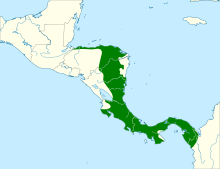Mistletoe tyrannulet
| Mistletoe tyrannulet | |
|---|---|

| |
| Scientific classification | |
| Domain: | Eukaryota |
| Kingdom: | Animalia |
| Phylum: | Chordata |
| Class: | Aves |
| Order: | Passeriformes |
| Family: | Tyrannidae |
| Genus: | Zimmerius |
| Species: | Z. parvus
|
| Binomial name | |
| Zimmerius parvus (Lawrence, 1862)
| |

| |
The mistletoe tyrannulet (Zimmerius parvus) is a very small bird, a passerine in family Tyrannidae, the tyrant flycatchers.
Taxonomy
The mistletoe tyrannulet was described in 1862 by the American amateur ornithologist George Newbold Lawrence under the binomial name Tyranniscus parvus.[2] It was formerly considered to be conspecific with the Guatemalan tyrannulet (Zimmerius vilissimus), but the species were split based on a molecular phylogenetic study published in 2013.[3][4]
Description
The mistletoe tyrannulet is a small bird, 11 – 12 cm in length as an adult. Adults have a slaty cap, a bright white supercilium ("eyebrow"), an olive-green back and conspicuous yellow edging along the wing.[5]

Distribution and habitat
Appearance
The mistletoe tyrannulet ranges from Guatemala and Honduras south to the extremity of northwestern Colombia. It can be found in humid evergreen forest and edge, cultivation and semi-open areas with large trees. It is a fairly common to common bird across its range.
Vocalizations
This species is a very frequent caller, incessantly giving a call that has been rendered variously as peeyaik, pee-peeu or pee-yuip and sounds similar to that of the thick-billed euphonia (Euphonia laniirostris), another mistletoe-loving species.
Behaviour
Nesting
The mistletoe tyrannulet's nest is a globular mass of rootlets, mosses and other plant matter, hidden in a tangle or growth or in an epiphyte. The clutch is two whitish eggs, speckled rusty.[6]
Feeding
The mistletoe tyrannulet is an active forager, moving quickly about with its tail cocked as it searches for prey, mainly arthropods, amidst the foliage. It can be found as a member of a mixed-species feeding flock.[7] The bird also takes fruit, preferentially that of mistletoes (order Santalales).
References
- ^ BirdLife International (2017). "Zimmerius parvus". IUCN Red List of Threatened Species. 2017: e.T103680835A112300016. doi:10.2305/IUCN.UK.2017-1.RLTS.T103680835A112300016.en. Retrieved 12 November 2021.
- ^ Lawrence, George Newbold (1862). "Description of six new species of birds from the Isthmus of Panama". Ibis. 4: 10–12 [12]. doi:10.1111/j.1474-919X.1862.tb07468.x.
- ^ Rheindt, F.E.; Cuervo, A.M.; Brumfield, R.T. (2013). "Rampant polyphyly indicates cryptic diversity in a clade of Neotropical flycatchers (Aves: Tyrannidae)". Biological Journal of the Linnean Society. 108 (4): 889–900. doi:10.1111/j.1095-8312.2012.02036.x.
- ^ Gill, Frank; Donsker, David, eds. (2017). "Tyrant flycatchers". World Bird List Version 7.3. International Ornithologists' Union. Retrieved 9 January 2018.
- ^ Ridgeley, Robert J.; Gwynne, John A. (1989). A Guide to the Birds of Panama.
- ^ Howell, N.G.; Webb, Sophie (2017). A Guide to the Birds of Mexico & Northern Central America.
- ^ Ridgeley, Robert J.; Gwynne, John A. (1989). A Guide to the Birds of Panama.
Howell, N.G.; Webb, Sophie (2017). A Guide to the Birds of Mexico & Northern Central America.
Ridgeley, Robert J.; Gwynne, John A. Jr. (1989). A Guide to the Birds of Panama.
- Articles with short description
- Short description matches Wikidata
- IUCN Red List least concern species
- Articles with 'species' microformats
- Taxonbars with automatically added original combinations
- Taxonbars without secondary Wikidata taxon IDs
- Zimmerius
- Birds of Guatemala
- Birds of Honduras
- Birds of Nicaragua
- Birds of Costa Rica
- Birds of Panama
- Birds of Colombia
- Birds described in 1862
- Taxa named by George Newbold Lawrence
